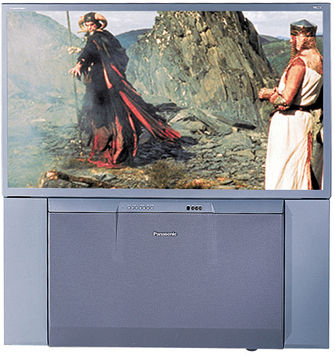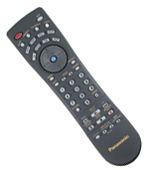The Monster TV Face Off Panasonic PT-56WX51
Many video enthusiasts have been eager for us to look at Panasonic's new sets. In the past, Panasonic has been the only manufacturer to offer TVs that display 720p HD programs in their native format. Other displays just convert the 720p signal to 1080i. Given the relative lack of actual 720p programming (ABC only recently started broadcasting their shows in 720p), Panasonic decided to forego that feature on this model. Now that ABC is broadcasting some HD material, it's too bad that we can't watch it as it's recorded.

Fortunately, the PT-56WX51 has more than enough inputs to accommodate any other home theater source, although some of the labeling is odd (for example, "Prog Out" means program out, not progressive out). This was the only set in our Face Off with a speaker-level center-channel input. While we don't recommend using the TV's speakers for the center-channel signal, the option is nice to have if you need it.
 You can assign the TV's speakers to center-channel duty through the set's onscreen menu, which uses a rotating virtual polygon that offers various submenus on each side. It looks strange but works just fine. The remote is similar. It fits comfortably in your hand, and most controls are within easy reach, although the Action button takes some getting used to.
You can assign the TV's speakers to center-channel duty through the set's onscreen menu, which uses a rotating virtual polygon that offers various submenus on each side. It looks strange but works just fine. The remote is similar. It fits comfortably in your hand, and most controls are within easy reach, although the Action button takes some getting used to.
 In addition to adjusting the basic picture settings, the menu offers further control over the image. For example, you can change the amount of red push that the color decoder uses. Unfortunately, I could never turn it down enough to satisfy everyone. Impressions ranged from "too red" to "a little pink." However, the red tint does help keep the set's bluish gray scale from making European fleshtones look washed out. The ever-present SVM undoubtedly helped boost picture sharpness. Most of the judging panel agreed with C Dogg that the image had good detail with both DVD and HD signals. Most of us would qualify, as Mr. HD did, that the image lost all detail in bright-white areas of HD signals. This effect was puzzling and was seen in only one other set in our Face Off (the Sony). This usually means that the contrast is set too high, but, even at the set's lowest setting, there was no difference. It was rarely noticeable, though, and both Adrienne and the Kid mentioned that they wouldn't have noticed it if others hadn't mentioned it. No matter where I set the contrast, the picture had a punchy dynamic range, thanks to the floating DC-restoration level. This means that blacks get darker with brighter images. Big Papa thought this made the image more three-dimensional but also made shadows less visible in bright scenes. He did like the line doubler, though, which did a reasonably good job of dealing with film sources and their subsequent artifacts, even though (like all of the other sets) the PT-56WX51 failed the official 3:2 test.
In addition to adjusting the basic picture settings, the menu offers further control over the image. For example, you can change the amount of red push that the color decoder uses. Unfortunately, I could never turn it down enough to satisfy everyone. Impressions ranged from "too red" to "a little pink." However, the red tint does help keep the set's bluish gray scale from making European fleshtones look washed out. The ever-present SVM undoubtedly helped boost picture sharpness. Most of the judging panel agreed with C Dogg that the image had good detail with both DVD and HD signals. Most of us would qualify, as Mr. HD did, that the image lost all detail in bright-white areas of HD signals. This effect was puzzling and was seen in only one other set in our Face Off (the Sony). This usually means that the contrast is set too high, but, even at the set's lowest setting, there was no difference. It was rarely noticeable, though, and both Adrienne and the Kid mentioned that they wouldn't have noticed it if others hadn't mentioned it. No matter where I set the contrast, the picture had a punchy dynamic range, thanks to the floating DC-restoration level. This means that blacks get darker with brighter images. Big Papa thought this made the image more three-dimensional but also made shadows less visible in bright scenes. He did like the line doubler, though, which did a reasonably good job of dealing with film sources and their subsequent artifacts, even though (like all of the other sets) the PT-56WX51 failed the official 3:2 test.
The PT-56WX51 is definitely configured to appeal to the average user. The various picture enhancements make the image seem more colorful, dynamic, and detailed than other displays, even though that picture isn't quite as accurate as it should be. If, like us, you're more interested in accuracy, you might want to look elsewhere. If you already own this set, you can rest assured that calibration will correct many of these issues. Given the display's cost, this may not be a bad way to go. We hope that, in future models, Panasonic will offer the video enthusiast the ability to disable some or all of these enhancements so that we can save our $300-to-$400 calibration cost and put it toward more DVDs.—MW
PT-56WX51 HD Monitor $3,500
Panasonic Consumer Electronics
(800) 211-PANA
www.panasonic.com
Dealer Locator Code PAN

HT Labs Measures:Panasonic HD Monitor


The top chart shows the gray scale of the Panasonic HD monitor as set by the manufacturer, in the most accurate menu setting possible. The set's gray scale doesn't measure on the black body curve and therefore doesn't appear as a color temperature without making adjustments. After making adjustments using the Photo Research PR-650, the gray scale measures within 300 Kelvin of D6500, the accurate setting, across most of the range. The bottom chart shows that the primary colors of the display's CRTs don't quite match those specified by SMPTE. Red is slightly orange, and green is noticeably yellowish. This means that the display won't quite reproduce all the colors available in the system. The gray scale, shown in the middle of the triangle, goes from being bluish-purple before calibration to being fairly accurate (the middle red dots) afterward. The light output was approximately 29 foot-lamberts with a white window, but only about 12 ft-L with a full-white field. The set needs a larger power supply to keep up with rapid changes in picture material. The display has poor DC restoration: Dark portions of the image get darker as the image gets brighter. The scan velocity modulation is not adjustable from the user mode. The color decoder pushes red, as set by the factory, but a technician can correct this from the service mode. The comb filter does a great job of eliminating dot crawl. The TV displays at least 500 horizontal lines (per picture height) with NTSC sources, as measured using the resolution pattern from the Ovation Avia test DVD played on a Sony CDP-650D DVD player.—MW/GM
- Log in or register to post comments




































































